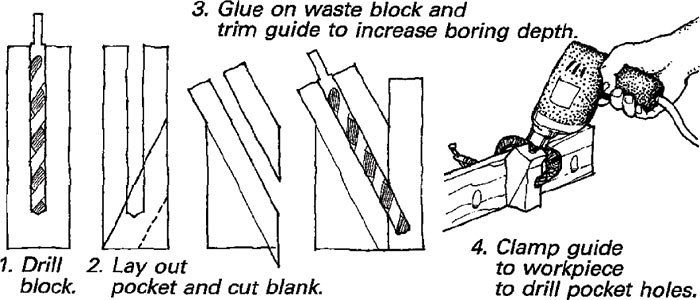Screw-Pocket Drilling Jig

This jig makes it simple to drill screw pockets, also known as pocket-holes, for a variety of tasks. Pocket-hole joinery is a quick and dependable method for securing a tabletop to its apron, attaching face frames to a cabinet, or building quick and functional frame-and-panel doors.
Start with a 1-in.-sq. by 4-in.-long hardwood block, and drill a 3/8-in. hole in the end of the block as deep as your drill will reach. Draw the profile of the hole on the side of the block, and decide how deep and at what angle (usually 25 degrees or so) you want your pocket. Then draw a line across the block to define the pocket, and saw the pieces in two along this angled line. Glue the sawn-off waste onto the other side of the block, as shown, to re-create a square corner. Now clamp the block to a scrap piece, and test-drill a pocket. Trim the end of the block to make the pocket deeper, if necessary.
To use the jig, clamp it securely to your workpiece and use it to guide your handheld drill as you bore the pocket. After you’ve drilled a pocket, finish by drilling a smaller through hole in the center of the pocket to accept a screw shank.
From Fine Woodworking #90
Drawings: Jim Richey

Jim Richey
Fine Woodworking Recommended Products

Starrett 12-in. combination square

Jorgensen 6 inch Bar Clamp Set, 4 Pack





















Log in or create an account to post a comment.
Sign up Log in